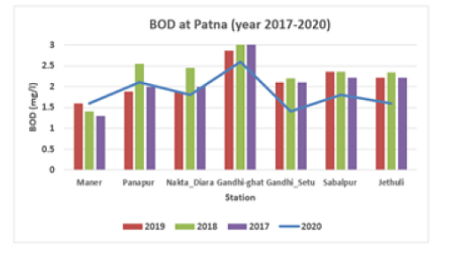


Indian Journal of Science and Technology
Year: 2021, Volume: 14, Issue: 29, Pages: 2439-2447
Review Article
Kamakshi Singh1, Ramakar Jha2*
1Research Scholar, Department of Civil Engineering, NIT Patna, India
2Professor, Department of Civil Engineering, National Institute of Technology, Patna
*Corresponding Author
Email: [email protected]
Received Date:07 February 2021, Accepted Date:29 July 2021, Published Date:08 September 2021
Objectives: To assess the impact of urban city Patna on water quality of the river Ganga during pre and post COVID-19 lockdown. Method: A study is done to assess the impact of point and nonpoint source pollution at different reaches of river Ganga for the years 2017 to 2020 (at a stretch of 40 km of a urban city in lower Ganga plains). A total of 450 datasets have been collected from eight river locations and two major drains. The equations of deoxygenation and reaeration coefficient used in water quality modelling have been tested for their applicability in the study area. Findings: Analysis of water quality data collected from 8 river locations and 2-drains for the year 2017-2020 shows significant improvement in water quality variables observed in river Ganga at Patna due to reduction in influx of point and non-point source pollution including floating population at Patna during COVID19 lockdown (March- June 2020). The use of BOD-DO developed by Streeter-Phelps (1925) as Oxygen-Sag curve is still valid, if input variables are limited. However, Camp (1963) and Jha et al. (2007) may be used effectively for comprehensive input data sets. Moreover, the refined model for predicting reaeration coefficient has been tested for the developed dissolved oxygen (DO) model and biochemical oxygen demand (BOD) model for pre- and post COVID19 lockdown individually. The water quality maps developed using satellite (Landsat-8) data provides the turbidity levels during pre and post COVID19 countrywide lockdown period and resulted in a significant improvement. Novelty: The study is unique due to water quality analysis during COVID19 and its comparison with previous year data. The deoxygenation and reaeration coefficients values are established for pre-and post COVID period. Also use of Landsat-8 data is used for assessing turbidity for pre- and post-COVID19.
Keywords: point source pollution; COVID 19; BODDO modelling; nonpoint pollution
© 2021 Singh & Jha. This is an open-access article distributed under the terms of the Creative Commons Attribution License, which permits unrestricted use, distribution, and reproduction in any medium, provided the original author and source are credited. Published By Indian Society for Education and Environment (iSee)
Subscribe now for latest articles and news.